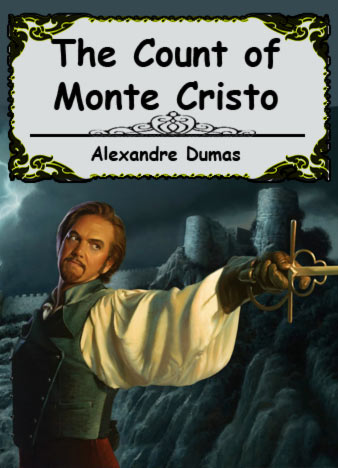A Critical Look At Alexandre Dumas' The Count Of Monte Cristo

Table of Contents
The Power of Revenge and Justice in The Count of Monte Cristo
Edmond Dantès' Transformation
Edmond Dantès' journey from an innocent, hopeful sailor to the vengeful Count of Monte Cristo is a central theme of the novel. Wrongfully imprisoned and robbed of his happiness, Edmond undergoes a profound psychological transformation. This metamorphosis is not simply a shift in identity; it's a descent into the dark side, fueled by the profound injustice he suffers.
- His methods of revenge: Edmond meticulously plans and executes his elaborate schemes, targeting each of his betrayers with calculated precision. He manipulates events, uses his newfound wealth and knowledge, and exploits the weaknesses of his enemies.
- Effectiveness of his revenge: While Edmond's plans are largely successful in bringing his enemies to ruin, the question of their moral implications remains. Does his revenge truly bring him justice, or does it further corrupt his soul?
- Moral ambiguity of revenge: The novel presents a complex exploration of justice versus vengeance. Edmond seeks justice, but his methods often blur the line, raising questions about the morality of revenge and its potential consequences. The line between righteous retribution and cruel vengeance is constantly tested. The reader is left to contemplate the ethical implications of Edmond's actions, even as they cheer on his triumphs.
The Exploration of Justice and Injustice
The Count of Monte Cristo is not simply a tale of revenge; it's a scathing critique of the French judicial system of the time. The novel vividly portrays the vulnerability of the innocent to the machinations of the powerful and corrupt.
- Examples of injustice: The false accusations against Edmond, orchestrated by Fernand Mondego, Danglars, and Villefort, highlight the flaws and corruption within the system. These men, driven by greed and ambition, manipulate the legal process to serve their own selfish interests.
- Commentary on societal corruption: Dumas exposes the pervasive corruption within French society, showing how power and wealth can be used to suppress truth and justice. The novel serves as a powerful indictment of a system that allows injustice to flourish.
- Injustice in The Count of Monte Cristo becomes a catalyst for Edmond's actions and underscores the novel's broader thematic concerns. The stark contrast between the injustice Edmond suffers and his quest for retribution forms the very heart of the narrative.
Character Development and Relationships in The Count of Monte Cristo
Complex Characters and Their Motivations
Beyond Edmond Dantès, The Count of Monte Cristo boasts a compelling cast of characters, each with their own motivations and flaws. Understanding their complexities is crucial to appreciating the novel's narrative depth.
- Fernand Mondego's motives: Driven by jealousy and ambition, Fernand's betrayal of Edmond stems from his desire for Mercédès and social advancement. His actions are a mix of personal vendetta and ruthless self-preservation.
- Mercédès' role: Mercédès, torn between her love for Edmond and her commitment to Fernand, represents the complexities of human relationships. Her choices significantly impact the course of the story.
- Abbé Faria's influence: Abbé Faria's mentorship provides Edmond with the knowledge and resources he needs for his revenge, while also instilling in him a sense of moral ambiguity about his actions. The Abbé's guidance is essential to Edmond's transformation, however morally ambiguous it may become.
- Danglars' avarice: Danglars, consumed by greed and a lust for power, becomes a key instrument in Edmond's initial downfall, and a prime target for his eventual revenge.
The Use of Romance and Betrayal
Romance and betrayal are intricately intertwined throughout The Count of Monte Cristo. These elements shape the characters' destinies and drive the narrative forward.
- Complexities of love and betrayal: The romantic relationships, particularly between Edmond and Mercédès and Fernand and Mercédès, are fraught with tension, deception, and ultimately, betrayal. The love triangle itself is a significant driving force of the plot.
- Betrayal's impact on Edmond's actions: The betrayal Edmond experiences fuels his desire for revenge, shaping his actions and defining his character. It provides him with both the motivation and the justification, however dubious, for his later course of action.
- Consequences of romantic choices: The choices made within the novel's romantic relationships have profound and far-reaching consequences, not just for the characters directly involved, but for the entire narrative and its many interwoven plots.
Literary Techniques and Narrative Structure in The Count of Monte Cristo
Plot Structure and Pacing
Dumas expertly crafts a suspenseful narrative, employing twists and turns to keep the reader engaged. The pacing, while sometimes meandering, builds anticipation and heightens the emotional impact.
- Effectiveness of plot structure: The multi-layered plot, with its intricate subplots and unexpected revelations, keeps the reader guessing until the very end. The interwoven narratives create a complex and captivating web of intrigue.
- Impact of pacing: The pacing effectively creates moments of both breathless suspense and quiet reflection, allowing the reader to fully experience the range of emotions. The slow burn of certain plot points only makes the climaxes more impactful.
Themes and Symbolism
The Count of Monte Cristo explores profound themes using rich symbolism. These elements provide depth and meaning to the narrative.
- Themes in The Count of Monte Cristo: Revenge, justice, redemption, fate, and the corrupting influence of power are just a few of the overarching themes that make this classic work endure.
- Symbolism in Dumas's work: The island of Monte Cristo itself is a potent symbol, representing both isolation and the potential for transformation. Other symbols, such as the treasure and the various objects representing wealth and status, contribute to the story's rich tapestry of meaning.
- Redemption in The Count of Monte Cristo: While Edmond's actions are driven by revenge, the novel also explores the possibility of redemption. The question of whether he achieves true redemption remains a subject for much critical interpretation.
Conclusion
This critical analysis of The Count of Monte Cristo has explored its powerful exploration of revenge and justice, its richly developed characters, and its masterful use of literary techniques. The novel's enduring appeal lies in its ability to engage readers on multiple levels, prompting them to contemplate themes of morality, justice, and the human condition. Having explored these critical aspects of The Count of Monte Cristo, we encourage you to embark on your own journey through this literary masterpiece, paying close attention to the intricate details and profound themes that continue to captivate readers worldwide. Re-reading The Count of Monte Cristo with a critical eye will undoubtedly reveal further layers of meaning and complexity within Alexandre Dumas’ classic tale of revenge and redemption.

Featured Posts
-
 Darjeelings Slow Moving Traffic A Growing Concern
May 04, 2025
Darjeelings Slow Moving Traffic A Growing Concern
May 04, 2025 -
 Corinthians Vs Guarani Guia Completo Para Assistir Ao Jogo Do Paulistao 2025
May 04, 2025
Corinthians Vs Guarani Guia Completo Para Assistir Ao Jogo Do Paulistao 2025
May 04, 2025 -
 Nhl First Round What To Expect From The Stanley Cup Playoffs
May 04, 2025
Nhl First Round What To Expect From The Stanley Cup Playoffs
May 04, 2025 -
 Prezident Frantsii Vyneset Reformy Na Referendum Podrobnosti
May 04, 2025
Prezident Frantsii Vyneset Reformy Na Referendum Podrobnosti
May 04, 2025 -
 Zuschauerzahlen Esc 2025 Vorentscheid Hitze Eins In Deutschland
May 04, 2025
Zuschauerzahlen Esc 2025 Vorentscheid Hitze Eins In Deutschland
May 04, 2025
Latest Posts
-
 Canelos Benavidez Snub A Case Of Mexican Disrespect Or Strategic Boxing
May 04, 2025
Canelos Benavidez Snub A Case Of Mexican Disrespect Or Strategic Boxing
May 04, 2025 -
 Canelo Alvarez One Word On Jake Paul And Rivals
May 04, 2025
Canelo Alvarez One Word On Jake Paul And Rivals
May 04, 2025 -
 Canelo Alvarezs One Word Verdict On Jake Paul And Other Boxers
May 04, 2025
Canelo Alvarezs One Word Verdict On Jake Paul And Other Boxers
May 04, 2025 -
 Exclusive Photos Bradley Cooper Directs Will Arnett In New York For Is This Thing On
May 04, 2025
Exclusive Photos Bradley Cooper Directs Will Arnett In New York For Is This Thing On
May 04, 2025 -
 Will Arnett And Bradley Cooper Spotted Filming Is This Thing On In Nyc
May 04, 2025
Will Arnett And Bradley Cooper Spotted Filming Is This Thing On In Nyc
May 04, 2025
